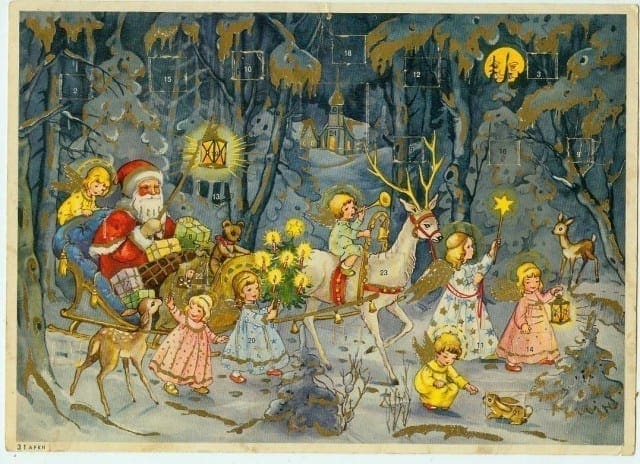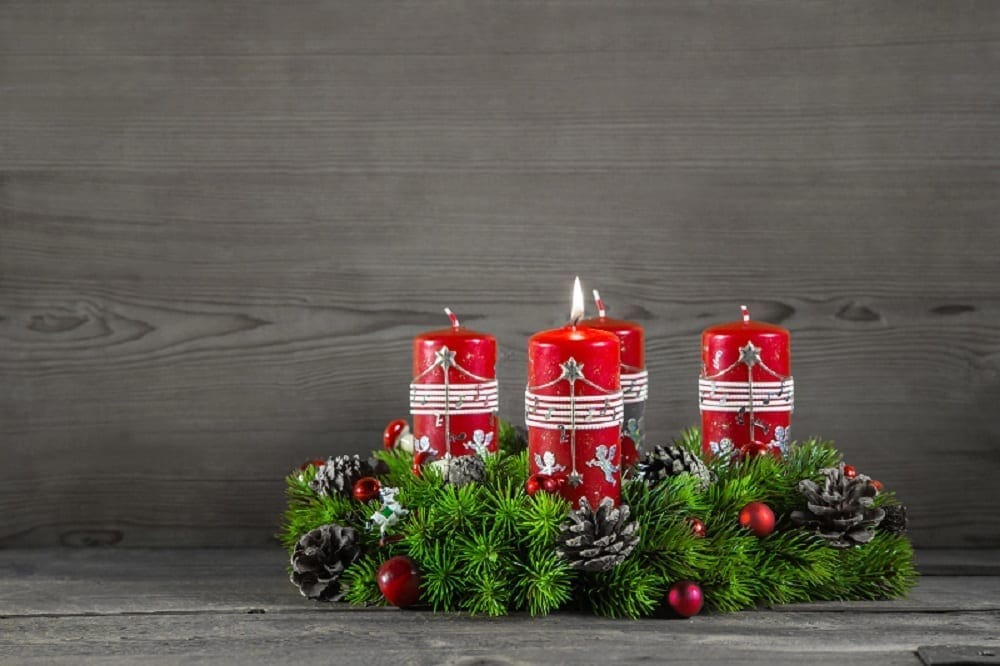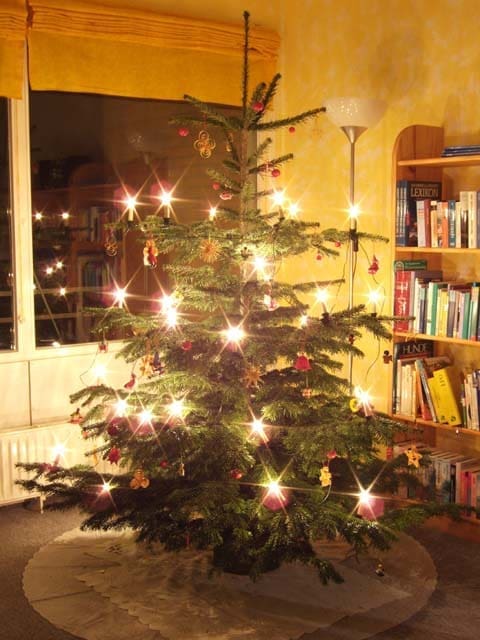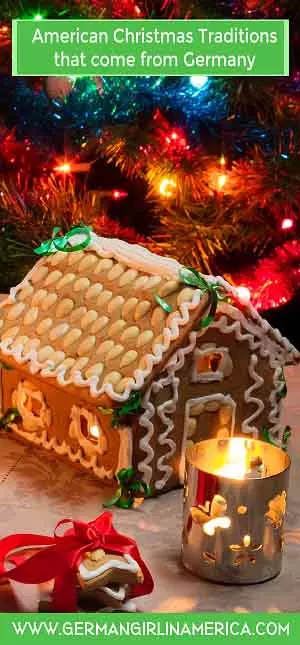No one does Christmas like the Germans, so it’s no great shock that many Christmas Traditions from Germany found their way to America. You can imagine it, can’t you? Prized ornaments wrapped in paper and safely tucked into suitcases next to hand written recipes for Stollen and Lebkuchen. Memories of celebrating German Weihnachten connecting them to home. It’s interesting to see HOW many of the Christmas traditions arrived in the United States… and how they were changed or modified to fit in with their new country. Christmas in America would be quite different if it wasn’t for those persistent Germans!
American Christmas Traditions from Germany

Advent Calendars
Once upon a time, a German Mother tried to help her son endure the ENDLESS wait for Christmas. She filled 24 little boxes with Lebkuchen, one for each day until Christmas Eve, and the first Advent Calendar was invented. Within a few years, a publishing company created “picture” Advent Calendars, with doors that opened to display a new image every day. Then came the CHOCOLATE Calendars. By the 1950s, Advent Calendars began to spread around the world. In America, a photo of President Eisenhower opening a door with his grandchildren spread their popularity outside the German-American population. Today you find Advent Calendars EVERYWHERE… and they aren’t just for kids. Advent Calendars contain everything from Chocolates to Beer and Wine. There are even Advent Calendars for pets!
Find lots of Advent Calendars HERE

Advent Wreath
A Wreath decorated with candles, a combination of greenery and light, goes back hundreds of years in German Christian Churches. Both Lutherans and Catholics claim that a version of the Advent Wreath has been a part of the Advent Church services since the 16th century. But, the modern Advent Wreath is relatively recent, and again, we can thank impatient children waiting for Christmas. In 1839, a Protestant Pastor working with orphaned children at a Mission school in Hamburg mounted 4 large white candles and 20 smaller red candles on a wooden ring. The white candles were for Sundays, and the red for the days in between. Each day a candle would be lit, and the children would know they were one day closer to Christmas! Soon the Advent Wreath was adopted by the Lutheran Church, with just the 4 Sunday Candles, and by the 1920s, the Catholic Church created their version too, using 5 candles (the 5th one in the center for Christmas). The Advent Wreath arrived in America around the 1930s. In the United States, they are seen primarily in Churches instead of homes.
Find beautiful Advent Wreaths HERE

Kris Kringle / St Nick / Santa Claus
There are three main Christmas gift-givers in Germany… St Nicholas, the Christkind, and the Weihnachtsmann. When they crossed the Atlantic to America, things got a little mixed up. Kris Kringle, St Nick and Santa Claus are more or less one being with three names.
St Nick
German St Nicholas arrives on St Nicholas Day, December 6th, bringing treats to fill children’s shoes. (Generally he travels with a companion who hands out punishment). In America, St Nick/ St Nicholas is another name for Santa Claus. But how did that happen? Things got a little mixed up in New York in the 1800s… St Nicholas was made the patron saint of New York, and 1809 Washington Irving wrote a story called “Knickerbocker’s History of New York” which featured a jolly St Nicholas figure called “Sankte Claus”, who dropped gifts down the church’s chimney. Then Clement Clarke Moore who cemented the story with his 1822 poem “An Account of a Visit from Saint Nicolas“. From then on St Nicholas or St Nick, was delivering presents in America down the chimney on December 24th.
Learn More about St Nicholas HERE
Santa Claus
“Sankte Claus” first appears in the US in Washington Irving’s 1809 history of New York. But the question is, where did the NAME come from? The Dutch will claim that it stems from “Sinter Klaas”… but, most likely it’s old-German dialect for Saint Nicholas, “Sankte Claas” (Sankt Ni Klaas). And his outfit? Red Suit? Fur trimmed hat? Boots and belt? Once again we can point to Clement Clarke Moores poem for inspiration, but the IMAGE comes from German Immigrant Thomas Nast. Nast was a political cartoonist, working for Harper’s Weekly. Between 1863 and 1886 thirty-three different Santa Claus illustrations, basing the look on his memories of Belsnickl, a St Nicholas companion he remembered from his youth in the Rhineland Palatinate. The Santa Claus figure is most closely related to the German Weihnachtsmann, another non-secular gift giver.
Learn more about the Weihnachtsmann HERE
Christkind
After the Protestant Revolution, Martin Luther wanted to stop the celebration of Saints, including St Nicholas. But, as every parent realizes, you can’t take away a special day with presents from kids, without coming up with a substitution, at least not without things getting loud around the house. Instead of receiving gifts from St Nicholas on December 6th, Lutheran kids would get their presents from the Christkind (or Christ Child) on December 24th. Of course, Catholic families soon took this tradition up as well. When Germans arrived in America, they brought the Christkind along… but somewhere along the way, the name changed to Kris Kringle, another name for Santa Claus.
Learn more about the Christkind HERE

Gingerbread Houses
Decorated Gingerbread or Lebkuchen has been a staple of German Christmas Markets for centuries, but it was the mention of a Gingerbread House in the Grimm’s Fairy Tale, “Hansel and Gretel” that set off the Gingerbread House craze in the early 1800s! (This was actually a Jeopardy question!) Suddenly, bakers were creating amazing fantasy houses with gingerbread and sweets. The Pennsylvania Germans brought recipes for Lebkuchen with them, and built Gingerbread Houses in America.
Nutcrackers
German Nutcrackers in the shape of Soldiers or Kings have been in use since the 15th century! The unsmiling figures are thought to be lucky, and provide protection for the household as they stand sentry on the mantle. Most came out of the Erzgebirge or Ore Mountains where miners made wooden toys and decorations. These Nutcrackers could actually crack nuts (unlike many of today’s cheap versions). In the 1950s American Soldiers stationed in Germany started visiting the Christmas Markets. They were captivated by these brightly painted wood “Soldier” Nutcrackers, and brought them home. Right around then Tchaikovsky’s ballet, The Nutcracker Suite was becoming a popular Christmas Event, and so demand for Nutcrackers skyrocketed! Now you find Nutcrackers with every imaginable theme from Soldier to Football Player.
Learn more about Nutcrackers HERE

Christmas Stockings
Christmas Stockings are most likely a twist on the St Nicholas legend. In Germany children put their shoes out on the night of December 5th, and wake to find them filled with treats on St Nicholas day, December 6th. But WHY? There are a few different theories. One story says that St Nicholas overheard some villagers talking about how their daughters would be able to get married because they had no dowry. That night St Nicholas threw gold bags through the window, and they landed in the stockings hanging by the fire, which meant the girls could marry. Another variation says her threw gold balls… which is why St Nicholas is sometimes represented by three gold balls (and why Oranges, which look like gold balls, get put into stockings). The word spread, and other people put out stockings… and then shoes (maybe filled with some straw for St Nicholas’s horse) to be filled. The tradition traveled across the Atlantic, and because in America, St Nick arrives on Christmas Eve, that’s when the stockings were hung.

Christmas Trees
Martin Luther gets most of the credit for bringing a Christmas Tree into the house. The story says he was walking home one evening, absolutely awed by the beauty of starlight in the trees, so he brought it inside with him in the form of a fir tree with candles. By the 1550s, most German Protestants set up Christmas Trees in their homes, and even through the early 1800s, Catholics set up Nativity scenes, not indoor trees. When Protestant Germans arrived in America, their Christmas trees weren’t welcome. In fact, they were outlawed as Pagan by early Puritans. Still, Germans persisted (not really surprised, are you?) and by 1830, the first Christmas Tree went up for public display in Pennsylvania. In the late 19th century early 20th century in the US, feelings shifted the Christmas Tree from a “German Tradition” to a universal Christmas tradition. One reason was the push by communities to make the holiday a “family centered” event with gift giving instead of “wassailing” (drinking). Today, Christmas trees are the focus of most Christmas celebrations in private and public.
Learn more about Christmas Trees Here
German Christmas Traditions
Since one in 5 Americans can trace their roots to Germany, it’s no wonder that American Christmas Celebrations are dominated by German Traditions. Thanks to German immigrants and influences, an American Christmas is a family centered Holiday with Christmas Trees, Advent Calendars and good old St Nick!



We have just returned to the US after living and working in Germany for 9 years. Your posts bring back the joy of living in a country of so many sweet traditions. Danke Schoen!
thank you
I enjoy your emails and site. When we lived in Kauserslautern in the 70’s, I loved a celery salad (selerei salat?) we could get at the cafeteria in the local Massa Markt. I have searched for a recipe forever. I think it was shredded celery root (celeriac?). I did find a root one time but it was impossible to shred. haha. Do you have any info about this salad and how to make it? It reminds me a little of the cucumber salad with milk or cream. I’m going to post this too on your facebook group. Maybe one of your members will have a solution.
You can order Sellerie Salat (and other German products) from Bavarian Sausage, Inc. in Madison, Wisconsin
You can easily make Sellerie salat at home https://germangirlinamerica.com/german-celery-root-salad-recipe-sellerie-salat/
I enjoyed your stories and accounts. I am second-generation German American but had a lot of contact with my German Grandparents (ALL 4!!). And I lived some of your experiences, like the special egg cups for hard-boiled or coddled eggs.Eating fork left, knife right and popping the food in the mouth fork upside dowm-more efficient!!) Rice pudding, WeihnachtStollen, Poppy Seed Stollen. Lebkuchen, Babka (Grandman Deissler traded her Stollen recipe for the Babka). I like your recipes, too ( GluehWein hat mir gut geschmekct!!) Alles Gutes, alles Besten im Neues Jahr!!
I wish I could be a child again. Christmas in Germany was magical. I believed that the Christ child dropped of present all the way till I was 12 years old. Karen, you look like a real German girl. You are quite pretty. Love all the interrsting story you bring us. I grew up in Germany, but there are many things, I never knew. I’m getting quite a lot of knowledge from your stories. Thank you so much. Between cooking, running a household and doing all the research, I don’t know how you can do all that. Do to my not being able to walk, due to my lower back pain, Christmas decoration, including cooking, is mostly the work of my 2 girls. We just to went all out. One time my then leaving husband, decorated the Mesquite trees. It turned out to be quite a job. After Christmas he tried to get the twinkling lights of those trees. It was almost impossible. The string of lights got so badly tangle up on the thorns of those tress. I had part of lights on those trees, that were still there a few years later. We never done that again. But my land that is full with those Mesquite trees looked enchanting. It had snowed that year, icesecules hung down everywhere. To me it looked like a fairy tale land. My whole land was glittering, and twinkling, and since we lived in the country, our place was the only one decoraded outside. I guess if people tried decorading their Mesquite trees, they learned their lesson fast. Now, everything looks bleak outside. After my husband passed away, Christmas has never been the same for me. The two of us enjoyed shopping together. At that time I could just walk perfectly. We had the Christmas spirit in us. Jesus our savior was born around the time. I read it was around February, but people will celebrate his birth on the 24th of December. I wish all of you a blessed and happy Christmas. I don’t know if can respond to any more of your web-sides this year, I have so many doctors appointment in December. One almost 2 or 3 days apart. I will be totally busy. I dislike every doctors visit. So far I feel the were all for nothing. Still have everything I went to see them. Plus every time I see a doctor, the always find something new wrong with me. Sure wished I could have some Glueh Wein, but that is out of the question for me. Have to take to many medication. Besides wishing all of you a blessed and happy Christmas, I will also include a happy and wonderful New Year. I will try and be back as soon as possible. Gigi Hammer. Much love to all of you.
Gigi… I’m always glad to hear from you. Wishing you a peaceful Advent Season.
(I now know to never decorate Mesquite!)